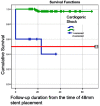Procedural Safety and Long-Term Clinical Outcomes in Patients Receiving Ultra-Long Everolimus-Eluting Stent: A Single-Center Real-World Experience
- PMID: 35465083
- PMCID: PMC8993437
- DOI: 10.14740/cr1357
Procedural Safety and Long-Term Clinical Outcomes in Patients Receiving Ultra-Long Everolimus-Eluting Stent: A Single-Center Real-World Experience
Abstract
Background: Diffuse long coronary lesions are difficult to treat percutaneously. The aim of the present study was to assess the procedural safety and long-term efficacy of the ultra-long (48-mm) drug-eluting stent Xience Xpedition.
Methods: This was an investigator-initiated, observational, all-comers study. A total of 92 patients with 93 lesions were enrolled in the study from October 2016 to October 2020. The primary outcome of the study was major adverse cardiac events (MACEs). Secondary outcomes were individual components of the primary outcome and procedural success.
Results: The mean (standard deviation (SD)) age of the participants was 58.8 (10.8) years. More than half of the patients had ST-segment elevation myocardial infarction (STEMI) at presentation (55.4%). Ten patients were in cardiogenic shock (CGS; 10.8%). Most of the lesions were located in the left anterior descending artery (48.3%). American College of Cardiology/American Heart Association (ACC/AHA) type C was the most common lesion type amongst the intervened vessels (46.74%), with a mean syntax score (SD) of 16.99 (8.89). The mean stent diameter used was 2.77 mm (0.25). MACE was observed in 7.6% of patients studied at a median follow-up of 24 months. MACE was significantly lower in the population without CGS, occurring in only 2.4% of the patients; a significant difference in MACE was observed in patients with and without CGS (P < 0.001). Procedural success was obtained in 89.2% of total population; however, 96.3% of patients without CGS had procedural success.
Conclusions: The deployment of the ultra-long 48-mm Xience Xpedition stent is feasible, safe, and effective; and it was associated with a good intermediate-term clinical outcome.
Keywords: 48-mm stent; Coronary artery disease; Percutaneous coronary intervention; Xience.
Copyright 2022, Senguttuvan et al.
Conflict of interest statement
The authors declare that there is no conflict of interest.
Figures
References
-
- Jurado-Roman A, Abellan-Huerta J, Requena JA, Sanchez-Perez I, Lopez-Lluva MT, Maseda-Uriza R, Piqueras-Flores J. et al. Comparison of clinical outcomes between very long stents and overlapping stents for the treatment of diffuse coronary disease in real clinical practice. Cardiovasc Revasc Med. 2019;20(8):681–686. doi: 10.1016/j.carrev.2018.09.009. - DOI - PubMed
-
- Claessen BE, Smits PC, Kereiakes DJ, Parise H, Fahy M, Kedhi E, Serruys PW. et al. Impact of lesion length and vessel size on clinical outcomes after percutaneous coronary intervention with everolimus- versus paclitaxel-eluting stents pooled analysis from the SPIRIT (Clinical Evaluation of the XIENCE V Everolimus Eluting Coronary Stent System) and COMPARE (Second-generation everolimus-eluting and paclitaxel-eluting stents in real-life practice) Randomized Trials. JACC Cardiovasc Interv. 2011;4(11):1209–1215. doi: 10.1016/j.jcin.2011.07.016. - DOI - PubMed
LinkOut - more resources
Full Text Sources

